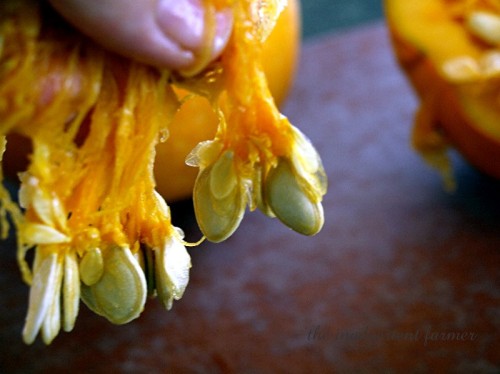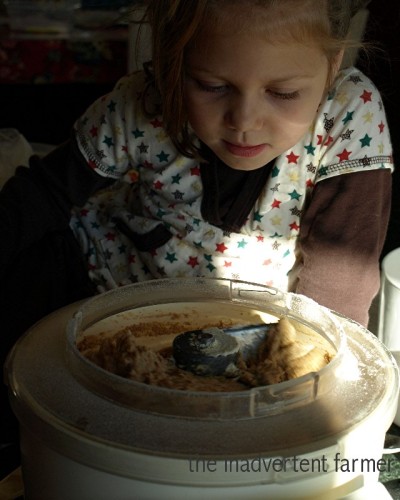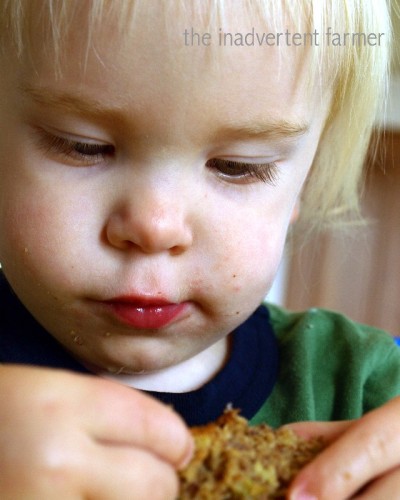
Iread an article over at Chiot’s Run the other morning about homemade ketchup that struck a note with me. We too have recently become fans of a homemade ketchup. It did take a while for us to make the switch but now that we have found the one I am not sure if we will ever go back completely to store bought.
I have noticed in my years and years of cooking that sauces are a VERY personal thing – – especially when we’re talking about home made. As a person who (without seeming as if I am patting myself on the back) is a pretty decent cook I have found that of all the things I make, sauces (ketchup, meat sauces, etc) are the most likely to be out right rejected by people who generally love my cooking.
I am not talking just my kids here, but friends who beg for recipes. For some odd reason we seem all to pretty much agree on store bought ketchup—I mean they’re like a total of 3 main brands in the U.S to choose from (but maybe the right word is tolerate).
Yet, when it comes to home made—watch out! Everyone, and I do mean everyone, has their own ideas on what makes a good ketchup.
And beyond that love it or hate it sauce mentality if you decide after reading this and Chiot’s Run’s article to make your own ketchup, be prepared to tweak and experiment with recipes. From what I have personally experienced, and heard other sauce makers comment on, a recipe is never perfect straight from the book–especially when it’s a sauce.
I also find it is important with condiments to make a small trial batch first before I can up 15 quarts. If I don’t I risk ending up with 14 and ½ jars of something that won’t get eaten. The other ½ jar was the part everyone tried and decided they didn’t like it.I offer that tid bit of advice with the best of intentions because of course years ago when I tried making ketchup for the first time that is exactly what I did. It was one of the years that I had a dearth of green tomatoes. Of course I often have that problem most years here in the south, but that was the year I thought I would try and be Lil Miss Homemaker and whip up some home made green tomato ketchup. Sounded good to me. Tomatoes, spices, vinegar —all the same no matter what recipe you find. Or so I thought. Well, needless to say that particular trial was a dismal failure. It was twangy and tart and overall not like anything I would enjoy swallowing with my fries. And, unfortunately, it kept me from trying to make ketchup for many years afterward because I just really wasn’t sure exactly what constituted “good” ketchup. Most store bought brands seemed to taste just like sugar and tomatoes so I wasn’t sure how to tweak the recipe to improve it. I just knew I had not liked that one. BBQ sauce? I know how to tweak that because there are so many many to choose from to give inspiration…. but ketchup….I was stumped.
Of course, as all you readers can understand, one of the reasons for trying to make ketchup was because I wanted to be able to move away from store bought that was lacking in flavor, full of corn syrups and ingredients I couldn’t pronounce and try to be just a bit more self sufficient. My usual reasons for doing anything. And I do realize that making ketchup does not put my household into the “never going to the store again” category…but hey, it gets a bit closer with each added thing. And ketchup was a “thing” I wanted to add. In addition it puts a quality product on the table. Or burger and fries anyway.
And if your wondering exactly why it failed I’ll have to go with the hot/cold/leftover explanation of cooking (that’s my official made up term for this dilemma). As everyone that cooks knows when your seasoning food while it is hot it tastes just a bit, and sometimes quite a bit, different than it does cool or cold or after sitting for a while to blend. Kind of like how our soups and stews always taste better leftover—all those spices blend together. Add heated vinegar to the tasting dilemma (ketchup is really a form of pickled fruit or vegetable pureed sauce) and it can get really bad in regards to taste distortion. At least while hot. Which is why you should always make notes in your pickle recipes, let them cool to sample, and never ever can 15 quarts right away.
Luckily all was not to end without ever finding a great ketchup….happily this year I did find a new recipe to try. And since I did not can 15 quarts right away….I will need to make more in the not too distant future. But that’s o.k. This one seems to be the perfect recipe for my family too. As a matter of fact my husband likes this ketchup SO much that he is about ready to carry it in my purse for when we do eat fries outside of home { notice I say MY purse 😉 }
We probably need to add one more ketchup recipe to our pantry since unfortunately this one is not completely sustainable for me since I can not grow the one main ingredient that sets it apart from other ketchups. And what is that you ask? Well, it is bananas for an absolutely fabulous Banana Ketchup. Yep…you heard me correctly. And I know you maybe wrinkling your nose at it—because most everyone does. But believe me if your into home made ketchups and sauces, you should like this. I am almost sure anyway. A number of our friends think it tastes just fine. Not at all like they expected it too when they first made their odd faces about it. Beyond the recipe the book I got it from is quite interesting so check that out too if you’d like. You can see it in the picture above and I linked off to it in addition.
Of course, I did tweak the ketchup a bit AFTER letting it sit over night and cool. I am teachable after all and do learn from my experiences most of the time. And this time I did find that it needed a bit of changing to fit my family’s tastes so I added almost double the bananas and tweaked the seasonings and vinegar just a teeny tiny bit.
No matter the changes, it was still good in its original form. But just a bit better my way I thought ;-).
So…here it is in its original form from the book The Good Stuff Cookbook by Helen Witty.
Hot and Spicy Banana Ketchup –Caribbean inspired fruit sauce
1 cup raisins, dark or golden
¾ cup chopped onion
3 or 4 garlic cloves, peeled
2/3 cup tomato paste
2 and 2/3 cup white or cider vinegar
3 pounds very ripe, fragrant bananas
4 to 6 cups water
1 cup packed dark brown sugar
1 tablespoon salt
1 teaspoon cayenne pepper (optional)
½ cup light corn syrup (I used regular sugar since I do not buy corn syrup)
4 teaspoon allspice, preferably freshly ground if available
1 and ½ teaspoons cinnamon
1 and ½ teaspoons grated nutmeg
1 teaspoon ground black pepper
½ teaspoon ground cloves
¼ to 1/3 dark rum (I did not use this at all)
1.Combine raisins, onion, cloves, and tomato in a blender or food processor and puree until smooth using some of the vinegar to help. Scrape into a preserving pan (or large stock pot).
2.Peel the bananas, cut them into chunks, and puree them using some of the vinegar again. Add to mixture in pan and add any remaining vinegar, plus 4 cups of water, the brown sugar, salt, and ground hot red pepper.
3.Bring the mixture to a boil over medium high heat, stirring frequently. Lower the heat to medium low and cook the ketchup, uncovered, for approximately 1 and ¼ hours, stirring often. If there is a threat of sticking at any point at water up to the remaining 2 cups (I did not ever add the extra water as the whole point is to cook the ketchup down until it is thick. Plus I did not have sticking issues at all.)
4. Add sugar and spices and continue to cook for another 15 minutes or until it is thick enough to coat a metal spoon. Don’t forget to stir. To test if the consistency is correct remove the pan from the heat and spoon a bit of the ketchup onto a saucer. Let it cool (put in fridge or freezer for a bit); if very little or no liquid emerges around the sample, the ketchup is thick enough. If it does not pass this test resume cooking for as long as necessary. Let the pan and contents cool for a few minutes when you get the correct consistency ( This was were I cooled mine overnight to allow for flavors to mingle so I could see if I would like the balance of flavors).
5. Puree the ketchup again in the blender or food processor until it is satin smooth. You can also force it through a fine metal sieve or food mill. Rinse out the pan and return ketchup and taste for hotness, sharpness and add more red or black pepper or more vinegar or sugar as needed. Be cautious about adding more of the spices because their flavors will strengthen later. They shouldn’t dominate the fruit.
6. Bring the ketchup to a boil again over medium heat, stirring constantly. Add the rum if you so choose and remove the pan from the heat. Ladle the boiling hot ketchup into hot, clean half pint or pint canning jars, leaving recommended head space. Seal with lids in a boiling water bath for 15 minutes for half pint and 20 minutes for pints. Wait at least two weeks for best flavors. (You can also store this in the fridge if you prefer not to can. Possibly in the freezer. One larger jar was in our refrigerator for about a month while we finished it. No problems encountered at all.) Makes about 7 cups.
After step 4, where I allowed the ketchup to cool over night, I then tweaked it. I found I wanted a bit more pronounced banana flavor and a slightly different balance of the spices. Both easily corrected. And to make sure you don’t ruin the whole batch put a small amount into a bowl and add your additions to see how the flavor changes there before doing the entire pot full.
Don’t think this is your style? The book also has a cranberry ketchup and a mushroom ketchup to try.
Anyone else have a unique ketchup they like that most people are unfamiliar with?
Read Full Post »








 As I was posting about our grape harvest on my blog last week I was drawn to the pictures of my children’s hands…
As I was posting about our grape harvest on my blog last week I was drawn to the pictures of my children’s hands…










































